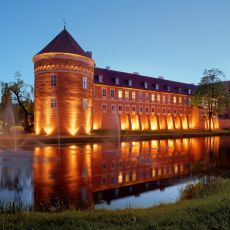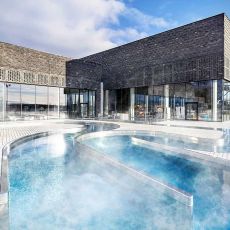Accommodation in Lidzbark Warmiński
Lidzbark Warmiński existed long before the Prussian Teutonic Knights of the Holy Hospital of the Virgin Mary of the German House in Jerusalem came to the lands. In 1241, they occupied the Prussian fortified town of Lecbark. In 1243, entire Prussian lands were divided into four dioceses - the largest of them was the diocese of Warmia. Lecbark received the first bishop of Anselm in 1250, the episcopal capital, however, it became only 100 years later (after Braniewo and Orneta) for the bishop Jan of Meisnia. At that time, the construction of the episcopal castle, admired to this day, was begun. Earlier, in 1308, Bishop Eberhard of Nysa gave Lidzbark the municipal rights of Chełmno. Today's city, lying at the mouth of the Symsarna River to Łyna, has about 16,000 inhabitants and is often visited by tourists and people associated with culture.
The most magnificent monument of Lidzbark Warmiński is the gothic castle - the seat of the Warmian bishops in the years 1350-1795. The powerful, four-winged assumption with perimeter walls and a vestibule is a perfect example of the architecture of those times. The courtyard of the high castle surrounded by two-storied cloisters with partially wall-mounted paintings is a real treat for lovers of medieval art.
The castle interiors are still beset by the dignity and authenticity of the form. The castle chapel has beautiful stellar vaults from the fifteenth century and later rococo furnishings. Inside, we find beautiful eighteenth-century paintings - including the "Mystical Marriage of Saint. Catherine of Alexandria "or" Crucifixion ". In the chapter-house we will see fifteenth-century gothic paintings - including the image of the first bishop Anzelma. In the great refectory, on the other hand, on the walls, we will find a complete group of the Ordinary of the Diocese of Warmia, we will enter the chapel of Łukasz Watzenrode in the main tower. Many castle rooms have been designated for permanent and temporary exhibitions.
We will find out a lot about the life of the inhabitants of the fortress and the region. You can also visit the armory, black chimney, dungeons, etc. In the part of the former buildings, the Hotel Krasicki currently functions. Going out of the castle and crossing the Łyna bridge, we get to the old city part. Here, the collegiate church of St. Peter and Paul from the fourteenth century. Inside equipment from various historical periods: neo-Gothic main altar, lateral baroque, tombstones. The Baroque-classicist building - the famous Krasicki's orangery - attracts the eye of the former garden areas. The building was erected at the beginning of the eighteenth century from the foundation of Bishop Teodor Potocki. Today, under the eloquent name of the Oranżeria Kultury, it has cultural functions. The city was significantly destroyed in 1945 - the major part of the old town was built up with modern facilities. Fragments of the walls have been preserved in the northern part. From the west, we will see an impressive element of the city fortifications - the fifteenth century przedbramie (colloquially referred to as the High Gate). At the exit from Lidzbark towards Bartoszyce (Markajmy), we can visit the so-called "Romanian cemetery". It is the burial place of nearly three thousand prisoners of war of various nationalities. In 1914-1919, a prisoner-of-war camp Slammlager Heilsberg functioned here. The cemetery was created for camp needs - the prisoners were decimated by the epidemic of typhus and the difficult conditions of camp life.
Lidzbark Warmiński is a good base for other interesting places in Warmia. Before we go on a further journey, we can relax and rest in a year-round building of the Warmia Therms.








